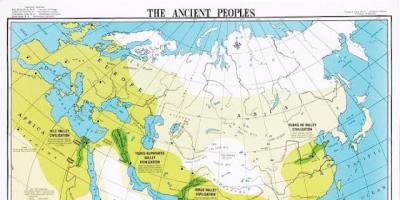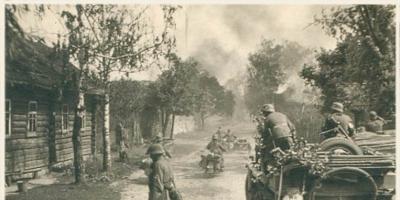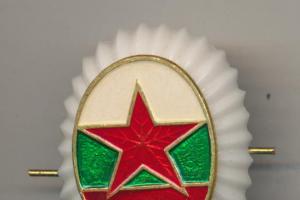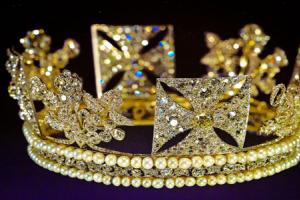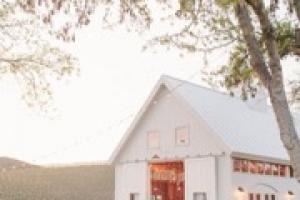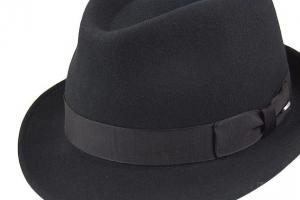Chinese gold characterized low consumer qualities.
However this best apples for making jams, baby food and juices, and therefore the variety is widely used in production.
In the garden, such an apple tree often acts as decorative tree.
Pollination
Occurs due to pollen from apple flowers self-fertile variety, since the apple tree belongs to self-sterile type. Ideally, plant strips of two varieties at a distance of five meters from one another.
Description of the variety Kitayka Zolotaya
The appearance of the apple tree is characterized by medium height, a dense light green crown and yellow, small fruits.
Tree medium height with a beautiful weeping crown shape. The branches are orange-yellow in color. The crown is quite spreading and lowered.
The shoots are greenish-yellow, thin and straight. The leaf is light green. It has an elongated shape with jagged edges.
The petioles are thin and long. Chinese golden apple trees are often used for decorative purposes.
Very small (average fruit weight is 40 grams), a beautiful, even yellow-amber hue, but with low consumer qualities.
The apple pulp is cream-colored with a yellowish tint, and has a granular consistency.
Apples are sweet in taste with a slight sour taste.
Photo
History of selection
Early summer variety of apple tree Kitayka golden bred I.V. Michurin. Produced by selective breeding White and Chinese pouring.
Region of natural growth
The natural growth zones for the Chinese golden apple tree are Northwestern and Volga-Vyatka region of Russia.
However, the variety is well adapted in other sunny regions.
If the climatic conditions are not suitable enough. It is important to ensure proper care, and above all, planting a tree (see below).
Productivity
Fruiting of the Chinese golden apple tree is coming in the third year after landing.
Maturation fruit occurs at the end of July(around the 25th).
Average yield per tree – 100 kilograms.
Within a week after harvesting, the apple fruits should be used.
Apple tree crumbles a lot during the ripening period.
Planting and care
The productivity of the apple tree directly depends on care. Golden Chinese apple tree unpretentious in care. When planting a tree, classic fertilizers are used.
Planting Chinese gold is desirable V autumn period(end of September - beginning of October).
Then you need to choose a landing site, it should be:
- in a sunny area;
- far away from groundwater(it is worth paying attention to this point, since the Chinese woman does not survive if this condition is not met);
- with fertile soil;
- well-drained areas with a pH of 5.5-6.5.
When choosing a seedling, it is important to consider the following:
It is necessary to select seedlings with a developed root system and purchase them in an area with the same climatic conditions;
It is better to choose a young seedling, then it will quickly adapt to the soil in the area where it is grown.
It is advisable to place plants with bare roots in water for an hour before planting.
Optimal pit parameters for planting an ornamental apple tree: 1x1x0.7m.
Upper layer The excavated soil is mixed with the bottom layer and the following fertilizers are introduced:
The hole is filled 2/3 with a mixture of soil and fertilizers. Fertile soil without fertilizers is poured on top. The pit is watered and a layer of fertile soil is added again.
REFERENCE American gardeners do not prepare planting holes in advance, but make them on the day of planting. They do not use any mixtures or fertilizers, but simply lay fertile soil in layers of 15 centimeters, alternating with dug up soil. The top layer must be fertile.
The next year after planting, in spring, it is important to shape the deciduous crown apple trees You need to trim the ends of each branch.
For the first two years, it is important that the apple tree is tied to a wooden peg (it is better to use linden or hazel wood).
Preferably during the first four to five years, do not allow the apple tree to form fruits(it is necessary to pick 80-100% of the flowers).
In the first year in April, it is imperative to irrigate the trees with mixtures that protect against pests.
This procedure should be carried out twice:
- when the buds began to swell on the branches;
- before the buds open.
Basic care during the first five years after planting:
- tying trees to protect them from rodents and hares (material – parchment, spruce branches);
- mulching tree trunk circles with humus;
- hilling with earth to a height of twenty centimeters.
Diseases and pests
Most often the Chinese apple tree is golden susceptible to the following diseases:
- scab;
- powdery mildew;
- tinder.
The golden Chinese apple tree is characterized by poor resistance to scab.
The peculiarity of this disease is that it first of all affects the leaves of the tree, and then moves to the fruits.
The trunk remains completely healthy.
The most common cause of this fungus is air stagnation inside the crown tree or high humidity.
The first signs scab are the appearance of green-brown spots on the leaves, also in large quantities small brown, crusty spots on the fruit.
To avoid scab damage, it is important to isolate the apple tree from other crops in the garden, carefully monitor the plant and constantly disinfect and fertilize the soil.
Scab prevention: adding ash to the soil, forming a crown, feeding with potassium fertilizers, fertilizing with compost.
Quite often in practice there are cases when the Chinese golden apple tree is exposed to powdery mildew.
Powdery mildew- This fungal disease. A characteristic sign of the disease is the appearance of mycelial fungus in the form white plaque on the leaves of trees.
Most often the disease manifests itself after heavy rains. Infection occurs along the tree from the bottom up until it completely attacks the tree.
The best way to combat this disease is its prevention, which consists of:
- pollination with colloidal sulfur and copper compounds;
- using varieties with high disease resistance;
- destruction of affected elements;
- application of potassium and phosphorus fertilizers.
Tinder fungus severely affects the trunk of the apple tree, but affects the fruits indirectly.
Such a fungus MUST be eliminated immediately.
The daily presence of the fungus on the bark draws out a lot of strength and nutrients that the apple tree needs for normal existence. If this is not done, the defeat process can be considered irreversible.
If the mushroom has not yet become too hard, you can use regular garden knife to cut it off. If the fungus has seriously affected the tree and has become very large and quite hard, you'll have to use an axe.
Naturally, healthy wood will also suffer.
It is important to destroy the fungus at its very roots. Otherwise, after some time, the mushroom will “settle” in the same place again.
After removing the infection, the place in which it grew should be disinfect.
The main thing is that the cut is even; most often it is possible to make a couple more cuts.
The treatment should be carried out copper sulfate, after which it is advisable to paint over the treated area oil paint.
If this is not done, the wound will soon become a nest for various types of pests.
The fruits of the Chinese golden apple tree are indispensable in the production of various jams, preserves, juices, compotes and various baby foods. Apples have sweet, honey taste. Apple trees are very elegant and are often used in the garden. as a decorative tree.
If you find an error, please highlight a piece of text and click Ctrl+Enter.
Chinese apple (paradise apple tree, Chinese plum apple tree) is grown in many countries around the world. The name Chinaki apple tree does not mean a specific variety, but a variety of varieties with similar characteristics. They appeared by crossing the Siberian berry apple tree with a low-growing garden apple tree. At the same time, the following varieties appeared: Kitayka golden early, Kerr, Bellefleur, Krasnaya and others.
Any of the Chinese apple trees is distinguished by its decorativeness, unpretentiousness, and resistance to drought and cold.
In the article:
Characteristics, description of the variety with photos
Depending on the variety, the apple tree has large, white, pink or red flowers. In summer, the branches are covered with clusters of golden, greenish-red or bright red fruits.
The fruits are spherical, small (in some varieties medium or large).
Not all varieties can boast of taste and long shelf life, but even from them you can prepare various delicacies.
Trees, depending on the variety, can be one meter tall or reach 9 meters in height.
The leaves of all varieties of Kitayka are pointed, elongated, and green. In autumn, the foliage on the trees turns purple or ocher. The root system is strong and shallow.

Golden early appeared when White filling was pollinated with pollen from the Chinaka apple tree. It is most often found in the Northwestern and Volga-Vyatka regions.
The apple tree is medium-sized, reaching 5-7 meters. Crown young tree broom-shaped. A mature tree has a weeping, spreading, pyramidal shape and consists of long, straight, thin branches.
The branches are open, growing under the trunk acute angle. The bark on young shoots is yellow; with age it becomes orange-yellow.
The leaves are light green, slightly pubescent and elongated. The edges have crenate serrations. The stipules are large. The petiole is elongated and thin.
The variety is fast-growing and early. For good fruiting, an apple tree requires proximity to a pollinating variety. The White Naliv and Grushovka Moskovskaya varieties are suitable for pollinating apple trees.
The apple tree bears fruit after 3 years. The harvest is harvested from mid-July to mid-August.
The fruits grow at the ends of the branches. Apples fall off quickly when ripe. The fruits are not suitable for storage.
They keep fresh for about 5-10 days. Immediately after collection they must be processed.
The fruits are round, small, 5-7 centimeters in diameter, weighing 30 grams. The peduncle is short. The skin is amber-golden. The pulp is dense, golden cream. The taste is pleasant, delicate, sweet and sour. The aroma is pronounced and pleasant.
The variety has high winter hardiness.
The disadvantages of the variety include average yield, small fruit size and susceptibility to scab. The fruits are not suitable for transportation. Their commercial quality is low.
Kerr

The Chinese Kerr was obtained from crossing the Chinese Long and the Haralson apple tree. The Canadian fruit variety Kerr is most often grown in middle lane Russia.
The tree is not tall. The crown is round, sparse, and does not require shaping pruning. The leaf blades are ellipsoidal, smooth, light green in color. The edges are slightly jagged, becoming sharper towards the top.
The flowers are large, bright, pink and fragrant.
Apple trees begin to bear fruit at 3-4 years of age. The harvest takes place in September. Productivity is high at first, alternating with age (in one year it is removed big harvest, the next – average). The fruits do not fall off when ripe.
When stored in a cold place, apples will last until January. During storage, the taste of apples acquires honey notes.
Apples of this variety are rich in vitamins C and P. The weight of the fruit does not exceed 45 grams. The shape is slightly elongated. The color of the skin is rich dark red. The taste is sour-sweet, a slight tartness is felt.
The variety is characterized by winter hardiness and disease resistance. This variety of apple tree is popular among landscape designers when designing plots.
Bellefleur

The Bellefleur variety appeared through cross-pollination of Chinata large-fruited and Bellefleur yellow. The variety grows in the North Caucasus, in the Central Black Earth region, Armenia and Ukraine. When grown in a temperate climate, it requires additional shelter for the winter.
Tall apple tree. The crown is round in shape. The branches are strong and powerful.
The shoots are pubescent, with light brown-red bark. The leaves are large, dark green, slightly pubescent below, oblong in shape. The edges have large crenate serrations, rise upward, and the tip points downward. The plate is matte, thin, leathery. The petiole is green.
The variety requires a pollinator variety. To pollinate an apple tree, you need to plant varieties such as: Kitayka Saffron, Autumn Striped, Slavyanka, Cinnamon Striped and Antonovka.
Fruiting begins after 7-8 years. Apples can be picked at the end of September. The fruits do not fall from the branches and are firmly held on their short stalks. Apples can be stored in a cool place for 4 months.
The variety differs from most Kitayka varieties in that it has large fruits weighing 120-300 grams (sometimes reaching more than 500 grams). The apples have a round-oval shape (with slight ribbing) and light yellow skin with bright red stripes on a pink background. Subcutaneous dots are light. The fruit stalk is short. The funnel is narrow and deep. The cup of the apple is shallow and closed. The saucer is wide, deep, the walls are almost even.
The taste of the fruit is sweet and sour, the aroma is pleasant and spicy. The pulp is snow-white, fine-grained, juicy, dense and tender.
Full ripening of the fruit occurs after harvesting the fruits after 2 weeks. The yield of the variety increases every year, and in adulthood it becomes periodic.
Apples have high commercial quality and are stored well.
With insufficient care or frequent rainfall, it is quite often affected by a disease such as scab.
The variety is not particularly winter-hardy and is not recommended for growing in cold regions.
Red

China Red is a fairly popular columnar variety. The variety is suitable for cultivation in any region, as the variety is winter-hardy. The apple tree is zoned for cultivation in the Central region.
The tree is low-growing, columnar. The branches are directed upwards. The foliage is bright green, elongated, pointed, finely serrated, with weak pubescence.
This variety of apple tree begins to bear fruit at 3-5 years. The apple tree begins to bear fruit in September. The yield is high, up to 165 kilograms of fruit are removed from the tree.
The fruits are small, weighing 25-75 grams. The apples are raspberry red. The shape is round and regular. The pulp is aromatic, juicy, sweet and sour.
Transportability is high. In a cold place (cellar, refrigerator) apples are stored for up to 55-60 days.
The variety is frost- and cold-resistant. Disease resistance is above average. The only drawback is the likelihood of scab.
Advantages and disadvantages
- Apple trees are suitable for landscape decoration. You can create hedges and garden figures from tree crowns.
- Chinese is suitable for rootstock of other apple trees (with the exception of a few varieties).
- Most varieties have good drought and frost resistance.
- Apple trees are unpretentious and grow on any soil.
- The fruits are suitable for preparing dessert dishes and preparations.
Each variety has its own advantages and disadvantages, but at the same time, with the right place and good care decorates the garden and produces beautiful and healthy fruits rich in vitamins and minerals.

Chinese apple trees are frost-resistant, drought-resistant and grow on almost any soil, but for a good harvest you need to create good conditions for growth. The soil should be non-acidic, light, moderately moist, predominantly loamy or sandy loam. Heavy, acidic or waterlogged soils are not detrimental to the tree, but have an adverse effect on the decorative appearance of the apple tree and the quality of the fruit.
The planting area should be light or slightly dark.
Trees need to be planted in early spring or in the fall, no later than October 15. The distance between apple trees should be 6 meters.
To plant on the site, you need to take two or three year old seedlings; older trees do not take root well in a new place.
Before planting, the roots must be soaked for a day in warm water, and then dipped in a clay mash before planting.
To plant an apple tree, you need to prepare a hole. The diameter of the hole should be 1 meter, the depth should be 80 centimeters. To fill the hole, take a fertile layer of soil, rotted humus, peat, wood ash, 260 grams of superphosphate and 120 grams of potassium sulfate are added to the mixture.
The mixture fills the hole by a third. A peg is driven into the middle. A seedling is installed nearby, everything is covered with fertile soil. After falling asleep, the root collar should rise above the ground at a level of 5-7 centimeters.
The tree trunk circle is trampled down, the tree is tied to a peg, watered with settled water and mulched with humus.
 Chinese Golden early
Chinese Golden early After planting, the tree needs to be properly cared for.
Caring for any of the Kitayka varieties is standard and includes:
- Watering;
- feeding;
- pest control and disease control;
- pruning
Apple trees require abundant but not frequent watering. A tree requires 3-4 buckets of warm water. After each watering, the ground around the tree should be covered with a layer of mulch made from crushed bark, dry sawdust, humus, peat or dry grass.
From the second year after planting, the first fertilizing is carried out. Under the tree in the spring (3 weeks before flowering) nitrogen-containing substances (urea or ammonium nitrate) and organic fertilizers.
For the second feeding, when the ovary is forming, take 250 grams of nitrophoska diluted in a bucket of water.
The third fertilizing is done after harvesting. Take 250 grams of superphosphate and 150 grams of potassium sulfate per bucket of water.
In autumn (before frost), the tree trunk is covered with a dense layer of humus.
The Chinese apple tree has fairly good resistance to most diseases and pests, but there are many factors that lead to a deterioration in the tree’s immunity and, accordingly, its damage.
To prevent a disease such as cytosporosis, the drug Hom and a solution of copper sulfate are used. Spraying is done in the spring.
Used to combat scab copper sulfate, Horus, Skor, Hom, Nitrophen, urea.
Trees can be threatened by apple pests such as aphids, apple moths, apple blossom beetles and others.
To combat aphids, a solution of soap and tobacco is used, which is used to generously spray the entire crown.
Apple moth and flower beetle can be defeated with the help of chlorine.

In early spring, dry, damaged branches are pruned.
In autumn, after the tree has shed its leaves, formative pruning of the crown is performed.
Formative pruning should be done from the second year of tree growth. First, 6 main skeletal branches are determined. Based on them, it is necessary to shape the crown annually. Shoots appearing below the first main branch must be removed. All crooked and incorrectly growing branches are cut off.
Before winter, the trunk is covered with roofing felt or spruce branches. This shelter allows you to protect the apple tree from rodents and cold. The tree trunk circle is covered with mulch.
In early spring, you need to clean up last year's leaves, grass and debris.
Since the root of the apple tree is located near the surface of the earth, loosening must be done using a rake. It is necessary to whiten the stem with a solution of slaked lime and copper sulfate. For a young tree you need to use a chalk solution. Then the tree is fed with fertilizers.
The Chinese apple tree, regardless of the variety, with good care, allows you to decorate the garden and gives good harvest fruits that are suitable for making preparations, desserts, cider and liqueur.
Chinese Apple Tree: video
Reviews:
The columnar variety Kitayka Krasnaya allows you to grow productive and beautiful tree without taking up much space. The tree is unpretentious and does not require pruning, which makes maintenance very easy. The apples are very beautiful and can be stored for up to 2 months. They make a very nice jam..
In my neighborhood garden there are two varieties of this apple tree growing: Bellefleur and Golden Early. What I like about the varieties is their bright flowering and the beauty of the fruits. The harvest is always good. I make marshmallows from early apples, and various preparations from Bellefleur.
I saw a Chinese woman in a friend’s garden. I really liked her decorative look. At the nursery I purchased a seedling of China Kerr. The tree is a real decoration of the site. It looks very beautiful in any season. The fruits, in addition, turned out to be a godsend for making compotes. Apples are stored until the new year, which allows you to always prepare fresh drinks.
This species is the Chinese Apple tree, they gave this interesting name“Chinese” because of the shape of the leaves, they are similar to the leaves of the Chinese plum. The Chinese was bred by crossing the domestic apple tree and the Siberian berry apple tree.

- The apple tree was bred by I.V. Michurin by hybridizing Kitayka and White filling. The resulting seeds sprouted in 1985, and the trees began to bear fruit in 1907.
- Chinese golden early is included in the State Register for the North-Western (includes: Nenets Autonomous Okrug, Republic of Karelia, Komi Republic, St. Petersburg and Leningrad, Murmansk, Arkhangelsk, Vologda, Novgorod, Pskov, Kaliningrad regions) and Volgo-Vyatka regions (composed of: the Republic of Mari El, the Republic of Mordovia, the Chuvash Republic, the Kirov Region) regions.
- The tree is 5-7 m high. The crown is very young, broom-shaped, and when it grows, it becomes spreading and weeping. The crown is formed from thin, long, yellowish-orange branches extending at an acute angle from the trunk. And the branches gradually become bare as they grow, that is, the leaves remain only at the top of the crown.
- The shoots are thin, straight, and have lime-colored bark. The leaves are light green in color, elongated, slightly pubescent, the edges of the leaves are crenate.
- The apples are small, their weight is 30 g, the main color is yellowish-amber, there is no top color, the stalks are short. The pulp is yellowish-white, tasty, but acid predominates. The fruits are eaten fresh and used to make wine, jam and jams.
Pollinator variety: Papirovka.
Advantages
- The variety is early-bearing, apples begin to set after 4-5 years;
- Early fruit ripening;
- Good frost resistance of apple trees;
- The fruit is quite tasty;
Flaws
- Fruits are not stored, they need to be used after 5-7 days; if you store them longer, their taste will become “cotton”;
- It is not recommended to cook jam, as the fruits quickly fall apart;
- Apples need to be picked immediately, as they fall off the trees;
- Trees are not resistant to scab and other diseases;
- The fruits are small, they are 5-7 cm in diameter;
Collection and storage
- The fruits ripen towards the end of July;
- They are collected quickly, as they can crumble;
- Apples are not stored longer than 7 days;
Review - Natalya, Moscow region
The fruits are 5-7 cm in size, in the west of the Moscow region they ripen in mid-August, they have a taste of honey and an amazing color, as if they glow in the sun. But apples don't last long. When stored for a long time, they taste like potatoes.
Kerr

- This Chinese variety was brought to Russia from Canada. The Chinese Kerr was bred by crossing the Chinese Haralson and Dolgo. Kerr is recommended for cultivation in the Ural (includes: Kurgan, Sverdlovsk, Tyumen, Chelyabinsk regions, Khanty-Mansiysk Autonomous Okrug - Yugra and Yamalo-Nenets Autonomous Okrug) and West Siberian (includes: Kemerovo, Novosibirsk, Omsk, Tomsk , Tyumen region,
- Khanty-Mansi and Yamalo-Nenets Autonomous Okrugs, Altai Republic, Altai region) regions, as well as in the Moscow region.
- The tree is not tall, the branches are sparsely spaced. It bears fruit in 3-4 years. It has elliptical leaves, they are pale light green, smooth, with small serrations on the edges, and the tops of the leaves are pointed. The flowers are large, crimson-pink, with a strong aroma.
- The fruits are slightly elongated, their weight is 35-40 g. The skin is burgundy. The pulp is sweet, with acid and tartness. Apples are used to make jams and compotes.
Advantages
- China Kerr is resistant to many diseases and drought;
- trees are frost-resistant;
- fruits do not fall off;
- give high yields;
- fruits set 4 years after planting;
Flaw
Fruits ripen late.
Collection and storage
- Apples are harvested from about September 15, but this depends on the planting area;
- fruits are stored for a long time - 3.5 months;
Review - Sergey, Ryazan region
The Kerr variety has three advantages
- Decorative. It blooms very profusely. It has many small but very bright apples.
- Since it blooms profusely, it serves as an excellent pollinator for other varieties of apple trees.
- You can eat apples or make jam from them.
Bellefleur-Chinese

- It was selected by I.V. Michurin by crossing yellow Bellefleur and large-fruited Chinata in 1908. Grown in the North Caucasus region.
- The tree is tall, quite branched, the crown has many branches and leaves, it is round in shape. The shoots are reddish-brown, drooping.
- The oval leaves have a bottle-like hue, they are fleshy, without shine, the edges have large crenate serrations, with drooping leaves at the bottom. Apples set on young twigs or last year's growths.
- The apples are round-oval, the ribs are slightly visible, the main color is technical ripeness- creamy, almost white when ripe. The average weight is 180 g, but there are apples weighing up to 500 g. The cover color is reddish-pink stripes on a fuzzy pinkish background. The peduncle is short.
Fruit composition

- glucose, fructose, sucrose - 11%;
- tartaric acids - 0.7%;
- vitamin C - 7 mg/100 g;
The fruit has a narrow, deep funnel. The saucer is deep and wide. The calyx is small and closed. The pulp is snow-white, delicate, with small grains, has a spicy, sweet and sour taste, with a bright aroma.
In trees, fruits are initially set every year, but as they age, fruiting becomes less periodic. From a hectare on which trees aged 20 years and older grow, up to 200 centners are collected.
Pollinator varieties: Antonovka, Cinnamon striped, Autumn striped.
Advantages
The fruits have a good dessert taste.
Flaws
- The tree is tall, making apple picking difficult;
- The variety is not resistant to scab;
- It has average resistance to frost;
- Fruits late, after 8 years;
Collection and storage
- The fruits ripen in mid to late September;
- After picking, leave them in a dry place for 2-3 weeks, then they will fully ripen and have an excellent dessert taste;
- The fruits can be stored for 2 months after collection. If you put them in the refrigerator, you can keep them until January.
Review - Malyshev, Bronnitsy, Moscow region
When stored, Bellefleur-Chinese apples become redder and more beautiful, and their taste becomes better. We start eating apples only a month after picking.
Chinese Red

- The tree was bred by V.V. Kichina in VSTISP. Apple trees can be grown in any region of Russia. This is a columnar apple tree.
- The tree is not tall, the branches are directed upward. It has emerald leaves, elongated in shape, their edges finely serrated.
- The variety is considered autumn. The main color of the fruit is creamy. The top color is a reddish-crimson continuous blush throughout the apple.
- Fruits are round in shape. The pulp is creamy, very juicy, has a dessert taste, there is sweetness and acidity, with aroma. Apples weighing 40-75 g. Tasting score for taste: 4.55-4.68 points. This universal variety, apples can be eaten and processed.
Advantages
- The fruits have excellent transportability.
- Up to 125-165 kg of apples are collected from a young tree.
- The apple tree begins to bear fruit in 3-5 years, that is, it is early-bearing.
- It is very frost-resistant.
- Has above average disease resistance.
Flaw

Trees may be affected by scab.
Collection and storage
- The fruits are harvested in September;
- The fruits do not fall off and adhere perfectly to the branches;
- They are stored after collection for about 2 months;
Review - Maria, Moscow region
I bought an apple tree in a nursery near Moscow. The apples are very tasty, sweet and sour with a strong aroma.
Landing

- The soil for china is selected that has neutral properties, crumbly, slightly moistened; loam or sandy loam is well suited. Choose a place that is sunny or slightly shaded.
- An apple tree is planted in early spring, when the buds have not yet begun to swell, but the ground has already thawed. But you can plant it in the fall, but no later than mid-October. If you plant an apple tree in the spring, then prepare planting pits in the fall, if in the fall, then dig holes a month before planting.
- For the columnar Chinese red apple tree, dig holes with a diameter of 50 cm and a depth of 50 cm. Maintain a distance of 1 m between the holes; it is best to plant columnar trees in one line.
- For other varieties of Chinawort, the pits should be 1 m in diameter and 70 cm deep. When planting Bellefleur-Chinese, make a distance of 5 m between the pits, and 6 m between the rows. And for Golden Chinawort and Kerr Chinawort, keep a distance of 4 m between the pits and 6 m between rows.
- Pour the top fertile layer of soil mixed with 2 buckets of humus, handfuls of ash, 260 g of superphosphate and 230 g of potassium sulfate into each planting hole. Then add 10 cm of soil without fertilizer. It is necessary that each hole is filled 1/3. Leave holes to allow the soil to settle.
- For planting, you should buy seedlings that are 1, 2 or 3 years old; older seedlings will not take root. If the seedling has an open root system, then lower the roots of the tree for a day before planting. warm water, and then dip it in a clay mash.
- Drive a peg into the middle of the hole. Place the seedling, carefully straighten the roots, cover with soil. When planting, the root collar should be 5-7 cm above ground level. Trample the ground a little trunk circle, water each seedling with 2-3 buckets of settled water, mulch with a 5 cm layer of humus. Tie each tree to a peg.
Care

Caring for a Chinese cat is:
- fertilization;
- watering;
- pulling out weeds;
- pest control and disease treatment;
- pruning;
- Apple trees should be watered abundantly, but not very often. Pour 3-4 buckets of water under one apple tree. After each watering, loosen the soil around the tree trunk shallowly. Then you can mulch with crushed bark, dried grass, and peat.
- They begin to feed from 2 years after planting. 3 weeks before the flower buds bloom, urea and rotted manure are scattered under the tree. The apple trees are fertilized a second time when they fade and begin to set fruit. Pour 250 g of nitrophoska into a ten-liter bucket of water and pour it under the apple tree.
- Feed the trees a third time after removing the apples. From August you cannot use nitrogen as fertilizer. Pour 250 g of superphosphate and 140 g of potassium sulfate into a ten-liter bucket of water. Before the onset of frost, place a ten-centimeter layer of humus under the tree.
- To prevent cytosporosis of apple trees in the spring, spray them with Hom or a solution of copper sulfate. To eliminate scab, use copper sulfate, Skor, Nitrofen, urea.
- To eliminate aphids, make a solution of tobacco dust and soap, and thoroughly spray the crown. Destroy apple moth and flower beetle with chlorine.
Formation of a columnar apple tree of the Kitayka red variety

- Immediately after planting, trim the main trunk and completely cut off all secondary shoots.
- After a year, pinch out all young shoots that are longer than 30 cm.
- After 2 years, pinch the top shoot 25 cm from the central trunk. Trim the side shoots, leaving 40 cm.
- After 4 years, cut through all the shoots from last year, cut off all weak and deformed branches.
- After 5 years, limit the tree's upward growth. A columnar tree should not exceed 3 m.
We will be glad to receive your advice for our gardeners about the Chinese apple tree, we are waiting for your comments.
And we also have

Our "paradise apples" - ToItalians, Siberians, Ranetkis . We mainly grow varieties in our gardens domestic apple trees (M. domestica). More than 10 thousand of them are known in the world assortment, but with all the variety of varieties that can withstand the conditions of severe frosty winters of the northern part of the Central, North-Western, Volga-Vyatka regions, this type of apple tree does not. Here you can plant varieties and hybrids of domestic apple trees with Chinese, Siberian and other types of apple trees.

Chinese, that is Chinese plum leaf apple tree (M. prunifolia), not found in the wild. It got its name not because it was brought from China, but because of the shape of the leaf, which resembles a Chinese plum leaf. Most often these are tall trees, up to 10 m, strewn with small apples. The taste of Chinese apples, of course, cannot compete with the wonderful southern varieties of apples. And they value it for its unpretentiousness and drought resistance, for the fact that it does not fail with the harvest even after harsh winters. And for amazing beauty during flowering and fruiting. There are many known forms that differ in growth vigor, size, shape and color of the fruit.
Among the most popular are durable and productive" Chinese woman Saninskaya"found back in 1899 in one of the gardens of Samara, with sweet and sour fruits (25-30 g, maximum up to 60 g), and highly winter-hardy" Chinese apricot". It is popular in the Chelyabinsk region. It produces up to 100 kg of fruit per tree (with an average weight of 56 g).
Authorship of varieties exceptionally hardy to frost" Chinese anise" (fruits about 50 g), " Chinese dessert", introduced into the assortment of the Vologda and Arkhangelsk regions and distinguished by good taste, as well as " Chinese golden early"belongs to Ivan Vladimirovich Michurin. The latter variety has a medium-sized tree, with a rather sparse narrow pyramidal crown. It begins to bear fruit in the 3-5th year after planting. The apples ripen early - in early August, but do not last long, a week or a week and a half. They small (30-40 g), round, golden-yellow, as if poured - translucent in the sun. The pulp is dense, yellowish, with a pleasant sweet and sour taste. The variety successfully bears fruit in conditions unfavorable for gardening in the North-Western and Volga-Vyatka regions.
The Chinese variety has been successfully grown in the Moscow region for more than 30 years. Kerr"Canadian selection. The tree is winter-hardy, small-sized, with a small sparse crown that does not require complex formative pruning. It begins to bear fruit at the age of 3-4 years, alternating a bountiful harvest with a moderate one. The apples are beautiful, dark red, weighing up to 40 g - hanging in garlands from the branches. They practically do not fall off and, collected in September, are stored in a cool place until December-January. They can become decorations for the New Year tree. But, most importantly, they are tasty fresh, and are especially good in all types of preparations - marmalade, jam , compotes, juices, cider, wine.
Chinese " Long"comes from the USA. It is short, begins to bear fruit early, and is resistant to scab. Every autumn it is literally strewn with bright red small fruits.
Siberia is the birthplace of frost-resistant type: apple berry tree (M. baccata), or Siberian. It is able to withstand frosts down to 50 °C and even more, and can exist without shelter at the latitude of Yakutsk. It grows in the form of a tree, sometimes a shrub. It has a wide, rounded crown and long, raised branches. The fruits are very small, like currants, yellow, orange, red. The tree is very beautiful during flowering, for example, the variety "Street Parade""the buds are pink, the flowers are white, and the variety" Hopa" - purple-pink with a lilac tint.
From crossing Siberian with large-fruited varieties, we obtained Ranetki
. These are highly winter-hardy, medium-sized trees, which in the third or fourth year begin to produce small (8-14 g) fruits. Known various shapes Ranetok - "Ranetka purple", "Ranetka Ermolaeva" and others. 
From crossing Ranetkas, first of all " Ranetki purple", with varieties homemade apple tree ("Papirovka", "Pepin saffron", "Melba" etc.) Siberian, Altai and Buryat varieties of apple trees were obtained: " Scarlet Flower", "Altai Dove", "Altai Crimson", "Altai Speckled", "Altai Purple", "Gornoaltaiskoe", "Winter Saffron", "Komsomolets of Buryatia", "Malink" a" and others. The fruits are 30-50 g, but the trees are very winter-hardy and bear fruit successfully, despite frosts of 40-45 ° C.
“Chinese” or “raika” is the common name for the incredibly beautiful, tasty and decorative tiny apples that were once often found in our gardens. In fact, a tree that produces such fruits is more correctly called a plum-leaved apple tree. In addition, “Kitayka” is not a variety, but a type of small apples, with several different varieties.
Features, descriptions and photos of varieties of Chinese apples
Frost-resistant, unpretentious and drought-resistant trees on which Chinese apples grow are also super-yielding and decorative both during flowering and during fruiting. By attracting bees to themselves, they help their neighbors pollinate, thereby increasing the productivity of the entire garden. They are often used as a rootstock.
The oldest of the varieties of this species, “Golden Early,” was selected by Michurin. Now this variety can only be found in old gardens. Golden apples ripen early and weigh no more than 40 grams. The fruits mainly grow at the ends of the branches of the miniature tree. Under the weight of the apples, the shoots often break, damaging the tree. The fruit is stored for only a few days.
In addition to "Golden Early", there is new variety – "Kerr" which comes from Canada. In their homeland they decorate with these apples christmas tree stuffing a bird for Christmas.

The aroma of these apples is not inferior to Antonovka. The rounded shape of the crown of low apple trees is maintained without pruning. Ripe apples resemble the color of Burgundy wine; they look impressive in small clusters on long petioles against the background of graceful leaves. The taste of the fruit is sweet and sour, with a barely perceptible tartness, which disappears after aging them on the tree until the first frost.
Apple tree "Chinese Bellefleur"- a vigorous variety with a rounded crown, large dark green leaves of an oblong shape. The shoots are heavily pubescent. The apples are large, oval, light yellow, with a pronounced blush. The pulp of the fruit is white, tender, spicy-sweet and sour with a dessert aroma.
The variety was developed by Michurin as a late-autumn variety. The apple tree participated in the selection of more than 10 new varieties. The disadvantages of "Belfleur-Chinese" include late fruiting of the variety, susceptibility to scab, and tall growth.

The nutritional value
Let’s look at why Chinese apples are valuable, using the example of the two most popular varieties – “Belfleur” and “Kerr”.
Use in cooking
Kerr apples are most often used for making compotes and jam. Goose stuffed with these fruits has a special, refined taste and aroma. Candied fruits are also made from them.
Bellefleur apples are also suitable for making jellies, mousses, wine, cider, jelly, and are good as dried fruits.
Below are several recipes for preparing delicious desserts from apples of the presented varieties.

Chinese jam
For 1 kg of apples with tails you need 1.5 liters of water and 1.5 kg of sugar. For a soda solution - 1 liter of water and 2 teaspoons of soda. The apples are pricked and placed in a soda solution for 2 hours. Then they are immersed in hot syrup and heated to a boil, and allowed to stand for 6 hours. Then the syrup should be boiled, the apples should be immersed in it and again set aside for several hours. Repeat this once or twice more. Then cook the fruits in syrup until tender.
Apple compote for the winter
In a sterilized three-liter jar, you need to put washed and dried apples so that they take up half the volume, add 2 cups of sugar and pour boiling water. Then the jars are rolled up, shaken so that the sugar dissolves, turned upside down and wrapped.
Bellefleur apple compote for the winter
The apples are peeled, peeled, cut into slices, and placed in jars. Then they are poured with boiling water with sugar (3:1), after 5 minutes the liquid is drained through a colander. This is repeated 2 times. For the third time, pour boiling syrup over the apples to the edge of the jar (there should be no air) and roll up.
Kerr apple jam (video)




